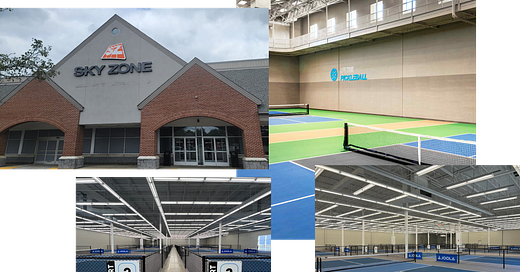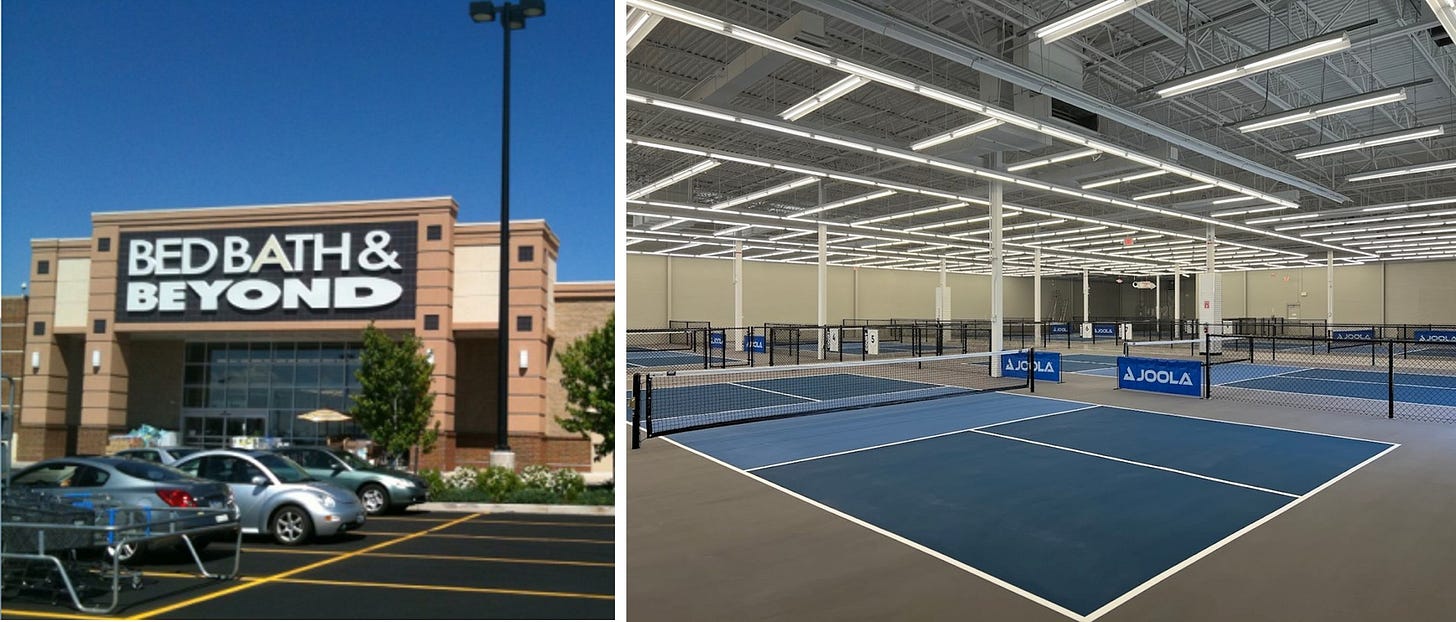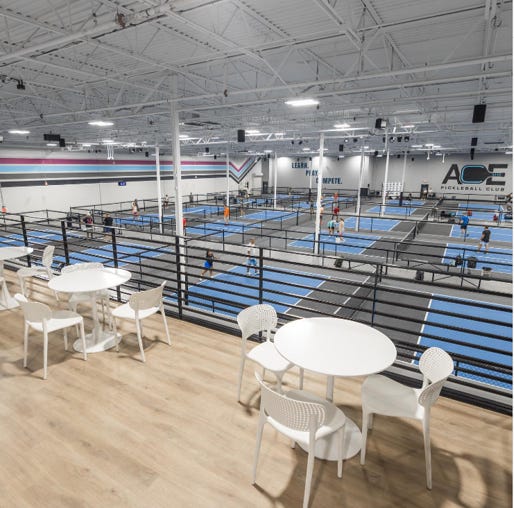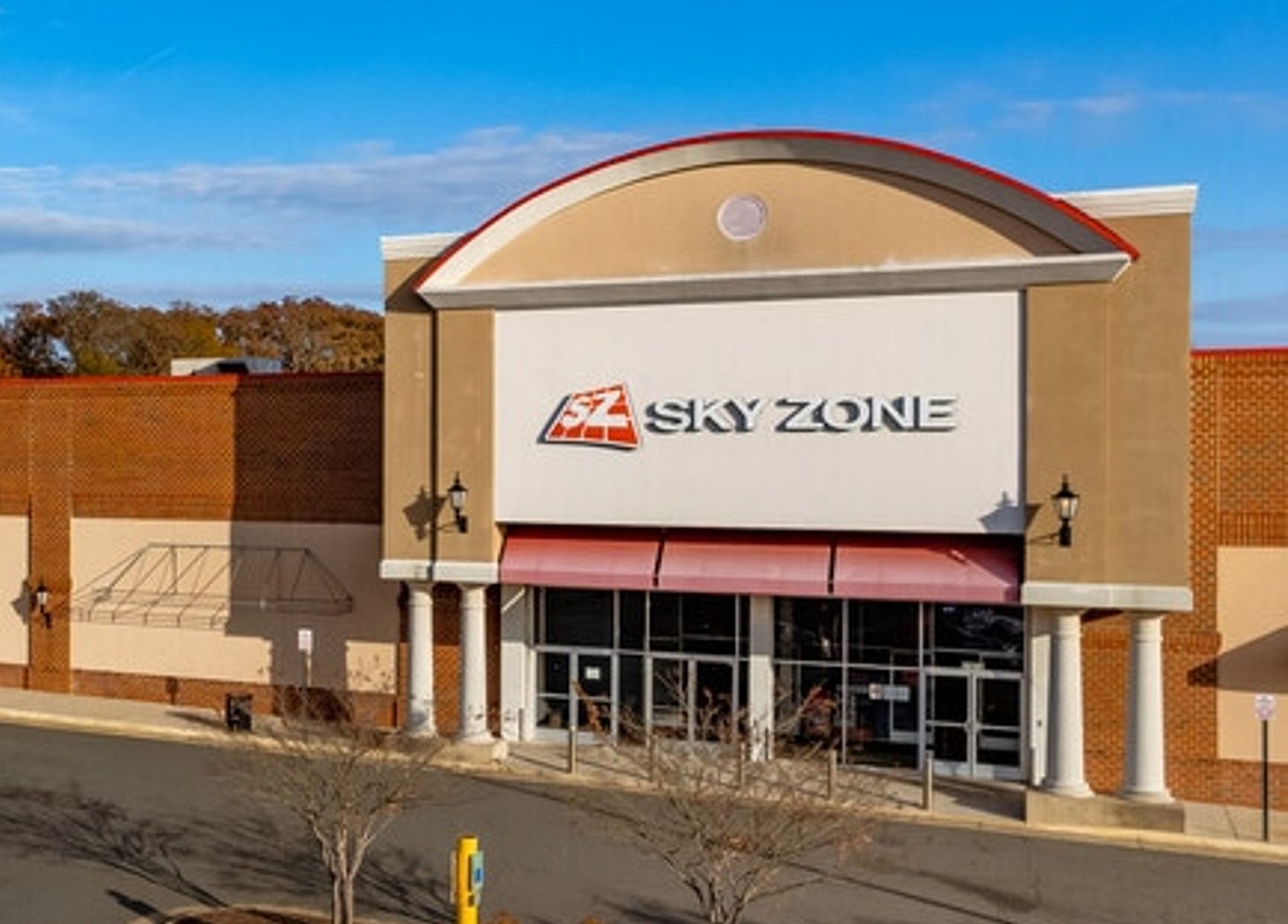Will Indoor Pickleball Centers Thrive in Big Box Retail Space? Trampoline Parks Offer A Cautionary Tale
The sport of pickleball is growing in popularity.
And so is the interest in turning vacant Big Box retail space into indoor pickleball centers.
One franchisor - The Picklr - will have seven indoor pickleball facilities open by the end of 2023.
But it anticipates it will have several hundred more operational within the next few years.
Other franchises such as Ace Pickleball, Dill Dinkers, and Pickleball Kingdom are also planning to open hundreds of facilities each over the next several years.
And Life Time Inc. - which currently operates over 600 pickleball courts throughout its network of fitness clubs and a goal to top 1,000 pickleball courts by the end of 2024 - has multiple indoor pickleball facilities open or in development.
But can thousands of indoor pickleball centers survive and thrive in former Big Box retail space?
The history of trampoline parks in Big Box space provides a cautionary tale.
Pickleball is America’s fastest growing sport.
The USA Pickleball Association reported that over 36 million people played pickleball last year and that its own membership increased by 30%.
There are now approximately 10,000 places to play pickleball throughout the country and approximately 130 new locations were added each month during 2022.
Given that weather is not conducive to outdoor pickleball play during winters in the North (or perhaps even summers in the South) - and with increasing complaints from residents in many communities about the loud pop sounds that occur during neighborhood pickleball games - some pickleball play is moving indoors.
As a result, many indoor pickleball courts and dedicated indoor pickleball facilities have now opened or are in development across the country.
Including in shopping centers and other former Big Box spaces - such as those that were previously occupied by retailers like Bed Bath & Beyond.
For instance, in April 2022 The Picklr opened a 9 court pickleball facility in a 22,000 square foot former Bed Bath and Beyond in Logan, Utah that was part of an early wave of store closures in advance of the chain’s ultimate bankruptcy.
Other indoor pickleball centers have opened (or are in development) at malls and Power Centers throughout the country.
And new indoor pickleball clubs, organizations and franchises are sprouting up as well.
Ace Pickleball Club is opened its first club earlier this year in a long vacant former CompUSA building in Roswell, Georgia.
Ace has already signed up multiple franchisees and expects to open 5 new clubs by the end of 2023 and 40 new clubs by the end of 2024.
And Life Time Inc. has leaned into pickleball as well.
Life Time expects to have nearly 700 pickleball courts - many that are indoor - at its 160+ fitness clubs by the end of the year.
It even converted its former fitness club in North Bloomington, Minnesota into Life Time Pickleball, a dedicated pickleball-only indoor club that offers not only five competitive level pickleball courts but also luxury locker rooms, whirlpools, saunas, fresh towel service and a large bar and lounge area.
Life Time is also currently developing its first ‘ground-up’ indoor pickleball facility in Chanhassen, Minnesota. That 25,000 square foot building - adjacent to a large Life Time Athletic Club - is expected to open early next year.
There are challenges to finding locations for - and operating - indoor pickleball centers.
For one, many Big Box spaces - including most former Bed Bath and Beyond suites - are located in shopping centers which have restrictive covenants that often prevent non-retail uses at the center.
Additionally, the ceiling heights at some Big Box buildings is too low to support pickleball play. And the column spacing in some suites can inhibit appropriate court sizes and layouts.
Many Landlords are also turned off by the lack of tenant history and the perceived "fad" nature of the sport - or the fact that many potential pickleball center operators often come with more of an "idea" than an actual business plan.
But these hurdles are not necessarily insurmountable.
In fact, the indoor pickleball center-in-a-Big Box space "craze" is somewhat reminiscent of the fervent interest that trampoline parks had in this same real estate beginning roughly 20 years ago.
At the time many Landlords were leery of filling their vacant Big Box spaces with trampoline parks.
Like with indoor pickleball centers, trampoline parks were considered by many to be a fad - and some Landlords were less than impressed with the lack of business plans, experience and financial wherewithal exhibited by some of the initial operators that sought to open new parks.
But many trampoline parks did open in these Big Box suites and shopping centers.
Nearly 20 years after Sky Zone opened one of the earliest indoor trampoline parks in Las Vegas in 2004, there are estimated to be over 800 indoor trampoline parks and family entertainment centers in the U.S. - the majority of which are located in former Big Box retail buildings and shopping centers.
And trampoline parks have been opportunistic when Big Box retail tenants have declared bankruptcy and vacated their real estate.
For instance, more than a dozen former Toys R Us stores were converted into trampoline parks.
Parts of at least 20 former Kmart buildings have also been converted into trampoline parks and family entertainment centers.
And approximately 5% of the 440+ re-tenanted former Sports Authority Big Box suites reopened as trampoline parks.
But even though hundreds of trampoline parks have opened in recent years, a significant number of these parks also later closed.
Including many that lasted just a couple of short years - or likely much less than their original lease term.
At least 100 trampoline parks closed during the COVID-19 pandemic due to the drop in demand and the restrictions on operating in many areas.
Other parks have closed due to their struggles to maintain insurance coverage as a result of significant lawsuits brought by patrons alleging injury and negligence at trampoline parks.
Still others simply could not a operate a as a profitable business and shut down their trampoline parks.
Many trampoline park closures resulted from the significant increase in competition from other nearby upstart parks - there simply was not enough to demand to support the glut in park supply.
And some trampoline parks have even failed multiple times in the same Big Box space!
To be sure, indoor pickleball centers do appear to have some advantages over trampoline parks.
While the economic model for indoor pickleball centers may still be a work in progress, pickleball appeals to a wider customer demographic than trampoline parks which largely cater to families with small children.
And pickleball does not carry with it the same safety and liability concerns that have plagued the trampoline park industry over its history.
But some of the other issues that led to trampoline park closures - such as significant competition, shaky business models, and inexperienced management - do appear to be a significant issue for indoor pickleball center operators.
And those landlords that plan to lease space to them.
It remains to be seen whether interest of pickleball center operators in vacant Big Box space will continue at its current fever pitch.
But would-be pickleball center operators (and those landlords that choose to lease to them) should keep in mind the cautionary history of trampoline parks in Big Box space.
Some indoor pickleball centers will surely survive over the long-term. Others may even thrive.
But it would not be a surprise to see hundreds of indoor pickleball center openings in the coming years met with dozens and dozens of closings of some of these same facilities a short time later.












